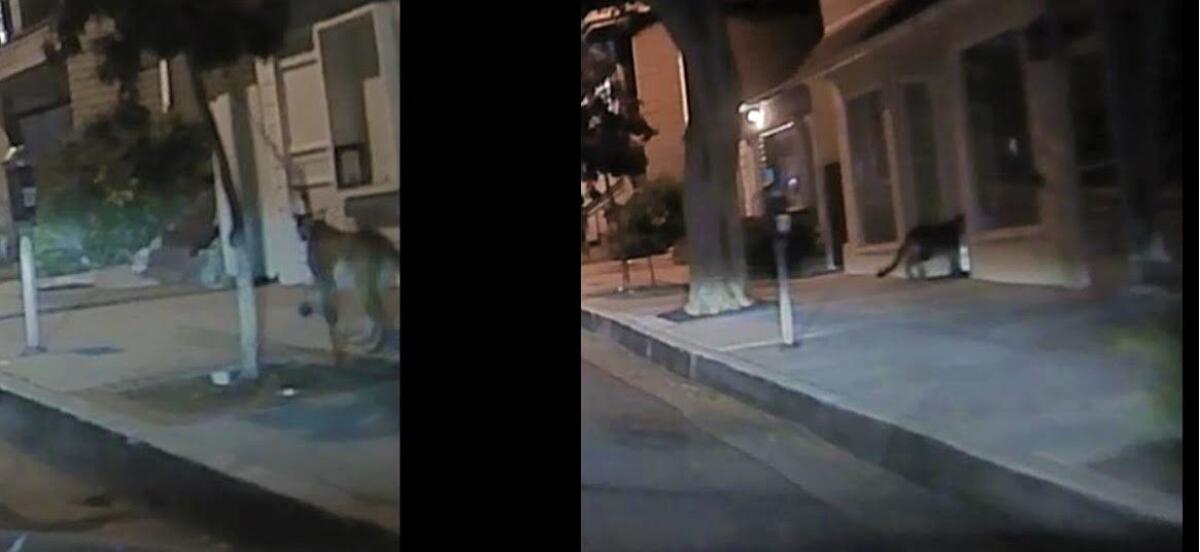Wildlife expert educates Laguna Beach community after mountain lion visit

- Share via
Following recent sightings of a mountain lion in town, a wildlife expert at the Laguna Beach City Council meeting Tuesday shared details regarding mountain lion behavior and advice should someone encounter one.
Rebecca Barboza of the California Department of Fish and Wildlife presented on living with a mountain lion in the area. The cats are a species that is a specially protected mammal, meaning it is illegal to take, injure, possess, transport or sell a mountain lion, with limited exceptions. They are also protected under the California Endangered Species Act.
It is within the nature of a cougar to be elusive, Barboza explained, and a Laguna Beach police official said the community’s recent feline visitor did nothing to dispel that notion when it was observed late Sunday night into early Monday morning.
“This past Sunday around 11:30, it was seen in the vicinity of Catalina and Calliope [Streets] by a resident,” Jim Beres, civilian services administrator for the Laguna Beach Police Department said. “It took off running, which was the behavior we would expect from a mountain lion.
“A couple hours later, around 1:30, it was observed by one of our police officers walking along the public sidewalk in the 600 block of South Coast Highway. The dash cam video captured some photos, which we released to the public. The mountain lion did take off and traverse an 8-foot-high wall into a residence.”
Beres added data acquired from a radio collar on the mountain lion, who is known as M317, showed it had retreated and taken refuge in the wildlife area near Laguna Canyon Road in the days following its sighting.
The relocation of a mountain lion is rarely considered, owing to a variety of factors.
The male cougar was seen at 11:30 p.m. Sunday near Catalina and Calliope streets and later on the 600 block of South Coast Highway. Officials say the 113-pound cat was the same one caught at an Irvine office building in March.
“For one thing, it moves a problem elsewhere,” Barboza said. “Now, this animal isn’t a problem. It’s behaving as it should, but if we were to remove a problem animal, it would be irresponsible of us as an agency to move such a problem into someone else’s backyard.”
Although mountain lions have large habitats, removal from an area can result in the issue of the cat being unable to locate natural resources, Barboza said. She added relocation leads to low survival rates for the animals involved due to causes such as competitors in the area, starvation and vehicle strikes.
The presentation made recommendations to protect a home with a mountain lion in the vicinity. Residents were advised not to attract prey animals, to install lighting in dark areas, and to cover up open areas beneath buildings to eliminate hiding spaces.
Barboza said the California Department of Fish and Wildlife fielded more than 800 calls concerning mountain lions throughout the state in 2018, and only one was deemed to constitute a public safety incident.
“Our predatory species in California do not see humans as prey,” Barboza said. “They’re not wired to hunt or kill [humans]. They actually fear us. They see us as another predatory-type animal, so they try to avoid us.”
Should the public encounter a mountain lion, they should not turn their back and run from the animal. They should attempt to appear larger than the mountain lion. Space should also be given to the mountain lion to leave the area on its own terms.
Vicki Long, a part-time resident of Laguna Beach and the president of the Cougar Connection, urged the public to drive carefully, fearful that the young M317 mountain lion could fall victim to a vehicle strike.
“If anybody could ever have a wonderful situation where a mountain lion could come down and visit once in a while, I think it’s Laguna,” Long said. “We’ve named him Laguna Leo. It’s just a nice way to remember that we have wildlife still living and functioning in Southern California.”
All the latest on Orange County from Orange County.
Get our free TimesOC newsletter.
You may occasionally receive promotional content from the Daily Pilot.








